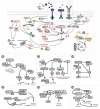Resistance to Targeted Therapy and RASSF1A Loss in Melanoma: What Are We Missing?
- PMID: 34066022
- PMCID: PMC8150731
- DOI: 10.3390/ijms22105115
Resistance to Targeted Therapy and RASSF1A Loss in Melanoma: What Are We Missing?
Abstract
Melanoma is one of the most aggressive forms of skin cancer and is therapeutically challenging, considering its high mutation rate. Following the development of therapies to target BRAF, the most frequently found mutation in melanoma, promising therapeutic responses were observed. While mono- and combination therapies to target the MAPK cascade did induce a therapeutic response in BRAF-mutated melanomas, the development of resistance to MAPK-targeted therapies remains a challenge for a high proportion of patients. Resistance mechanisms are varied and can be categorised as intrinsic, acquired, and adaptive. RASSF1A is a tumour suppressor that plays an integral role in the maintenance of cellular homeostasis as a central signalling hub. RASSF1A tumour suppressor activity is commonly lost in melanoma, mainly by aberrant promoter hypermethylation. RASSF1A loss could be associated with several mechanisms of resistance to MAPK inhibition considering that most of the signalling pathways that RASSF1A controls are found to be altered targeted therapy resistant melanomas. Herein, we discuss resistance mechanisms in detail and the potential role for RASSF1A reactivation to re-sensitise BRAF mutant melanomas to therapy.
Keywords: DNA methylation; RASSF1A; melanoma; resistance; targeted therapy; tumour suppressor.
Conflict of interest statement
The authors declare no conflict of interest.
Figures


Similar articles
-
p53 Reactivation by PRIMA-1(Met) (APR-246) sensitises (V600E/K)BRAF melanoma to vemurafenib.Eur J Cancer. 2016 Mar;55:98-110. doi: 10.1016/j.ejca.2015.12.002. Epub 2016 Jan 17. Eur J Cancer. 2016. PMID: 26790143
-
Resistance mechanisms to targeted therapy in BRAF-mutant melanoma - A mini review.Biochim Biophys Acta Gen Subj. 2021 Jan;1865(1):129736. doi: 10.1016/j.bbagen.2020.129736. Epub 2020 Sep 18. Biochim Biophys Acta Gen Subj. 2021. PMID: 32956754 Review.
-
Frequent alterations of Ras signaling pathway genes in sporadic malignant melanomas.Int J Cancer. 2004 Apr 10;109(3):377-84. doi: 10.1002/ijc.11722. Int J Cancer. 2004. PMID: 14961576
-
A Feed-Forward Mechanosignaling Loop Confers Resistance to Therapies Targeting the MAPK Pathway in BRAF-Mutant Melanoma.Cancer Res. 2020 May 15;80(10):1927-1941. doi: 10.1158/0008-5472.CAN-19-2914. Epub 2020 Mar 16. Cancer Res. 2020. PMID: 32179513
-
MAPK pathway in melanoma part II-secondary and adaptive resistance mechanisms to BRAF inhibition.Eur J Cancer. 2017 Mar;73:93-101. doi: 10.1016/j.ejca.2016.12.012. Epub 2017 Feb 3. Eur J Cancer. 2017. PMID: 28162869 Review.
Cited by
-
Interaction of LATS1 with SMAC links the MST2/Hippo pathway with apoptosis in an IAP-dependent manner.Cell Death Dis. 2022 Aug 8;13(8):692. doi: 10.1038/s41419-022-05147-3. Cell Death Dis. 2022. PMID: 35941108 Free PMC article.
-
Mechanisms of Melanoma Progression and Treatment Resistance: Role of Cancer Stem-like Cells.Cancers (Basel). 2024 Jan 22;16(2):470. doi: 10.3390/cancers16020470. Cancers (Basel). 2024. PMID: 38275910 Free PMC article. Review.
-
Exosome-delivered circRPS5 inhibits the progression of melanoma via regulating the miR-151a/NPTX1 axis.PLoS One. 2023 Jun 29;18(6):e0287347. doi: 10.1371/journal.pone.0287347. eCollection 2023. PLoS One. 2023. PMID: 37384727 Free PMC article.
-
Proteasomal down-regulation of the proapoptotic MST2 pathway contributes to BRAF inhibitor resistance in melanoma.Life Sci Alliance. 2022 Aug 29;5(10):e202201445. doi: 10.26508/lsa.202201445. Print 2022 Oct. Life Sci Alliance. 2022. PMID: 36038253 Free PMC article.
-
Advances in Melanoma: From Genetic Insights to Therapeutic Innovations.Biomedicines. 2024 Aug 14;12(8):1851. doi: 10.3390/biomedicines12081851. Biomedicines. 2024. PMID: 39200315 Free PMC article. Review.
References
-
- Goldstein A.M., Chan M., Harland M., Gillanders E.M., Hayward N.K., Avril M.F., Azizi E., Bianchi-Scarra G., Bishop D.T., Bressac-De Paillerets B., et al. High-risk melanoma susceptibility genes and pancreatic cancer, neural system tumors, and uveal melanoma across GenoMEL. Cancer Res. 2006;66:9818–9828. doi: 10.1158/0008-5472.CAN-06-0494. - DOI - PubMed
Publication types
MeSH terms
Substances
Grants and funding
LinkOut - more resources
Full Text Sources
Medical
Research Materials

